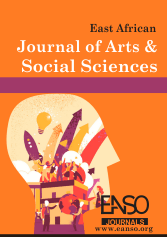Techniques Used in Translation of Proverbs in Siku Njema by Ken Walibora
Abstract
Proverbs play a very important role in any cultural society such as to inform, caution, and inspire people in their daily lives, among others. Generation after generation, proverbs have endured, offering insights and direction that people still find meaningful to date. This research, is concentrating on the numerous approaches, which were employed by the translators Dorothy Kweyu and Fortunatus F. Kawegere to translate Siku Njema by Ken Walibora. This research highlights several approaches used in the translation process, including direct translation, equivalence, and omission, utilizing diverse methodologies such as the descriptive method which is utilized to explain each proverb, translating them from their original language to the target language while maintaining their contextual meaning. By taking this approach, the proverb's core meaning is maintained, enabling readers to completely understand its significance. The analytical method is also used, which allows for a greater comprehension of the complexity and cultural significance of each proverb. To capture details that could otherwise be lost in translation, this analysis is crucial. The comparative technique enhances the research even more and offers insights into how various cultures understand related issues by contrasting proverbs in their original form with their translated counterparts. Last but not least, the proverbs in "Siku Njema" are methodically chosen and examined using corpus analysis. In addition to aiding in the identification of important phrases, this approach makes it easier to comprehend how they are used throughout the text. The research intends to clarify the difficulties in communicating cultural meanings through language by looking at these different translation techniques, which will ultimately improve our understanding of the source material and its translation. This thorough examination highlights the proverbs' timeless value in fostering cross-cultural understanding and improving communication
Downloads
References
Brown, H. D. (2006). Principles of language learning and teaching (5th ed.). Pearson Education.
Dimitriu, R. (2004). Omission in translation. Perspectives, 12(3), 163–175. https://doi.org/10.1080/0907676X.2004.9961499
Davies, E. (2003). A gobbledygook-free guide to translation: The role of omission in translation. St. Jerome Publishing.
Kelly, D. (2014). A handbook for translator trainers. Routledge.
Meider, W. (1985). Proverbs: A handbook. Greenwood Press.
Newmark, P. (2003). A textbook of translation. Prentice Hall.
Walibora, K. (1996). Siku Njema. Kenya: Longhorn Publishers. Walibora, K. (2019). A Good Day. (Dorothy Kweyu, Fortunatus F. Kawegere, trans). Kenya: Longhorn Publishers.
Venuti, L. (1995). The translator's invisibility: A history of translation. Routledge. Vinay, J. P., & Darbelnet, J. (1995). Comparative stylistics of French and English: A methodology for translation. (J. C. Sager & M. J. Hamel, Trans.). Amsterdam / Philadelphia: John Benjamins.
Zanettin, F., & Rundle, C. (Eds.). (2022). The Routledge handbook of translation and methodology. Routledge. https://doi.org/10.4324/9781315158945.
Copyright (c) 2025 Lilian Mumbi Benard

This work is licensed under a Creative Commons Attribution 4.0 International License.




























